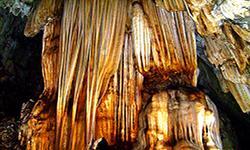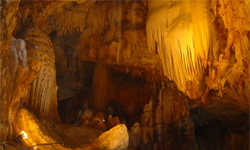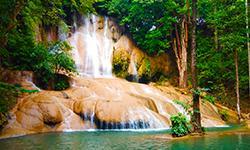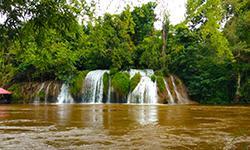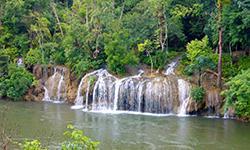Sai Yok National Park
Contact Location : Sai Yok National Park, Moo 7, Sai Yok Sub-district, Sai Yok District, Kanchanaburi Province.Sai Yok National Park, Moo 7, Sai Yok Sub-district, Sai Yok District, Kanchanaburi Province.
Telephone Number : (+66) 3 468 6024, (+66) 8 9028 1958
Email : saiyok_np23@hotmail.com
Facebook : Sai Yok National Park
Information
The majority of the features is that of karst topography, with an average slope gradient of about 35% and elevations ranging from 300 to 1,125 meters above sea level. The highest point is Ro Rae Mountain range, which is approximately 1,125 meters high, and the area is full of significant waterways such as Khwae Noi River, Noi River, and Lo River. This section of the mountain range runs north to south. It is bordered to the north by Huai Khayeng National Reserved Forest, and to the south by Wang Yai Mae Nam Noi National Reserved Forest. The east borders Erawan National Park and the west borders with Myanmar.
Background
His Majesty King Chulalongkorn, Rama V, visited Sai Yok Waterfall and bathed in the cool stream underneath the large forest, which inspired His Royal Highness Prince Narisaranuvatiwongse composingto write the song "Khamen Sai Yok" which is about the beauty of Sai Yok Waterfall. The area became famous all over Thailand and in some parts of the world. Historically, the forest areas of Wang Yai Forest and Noi River Forest in Lin Thin Sub-district at Thong Pha Phum District, also Sai Yok, Lum Sum and Sing Sub-districts at Sai Yok District, were designated as National Reserved Forests by Ministeri al Regulation No. 417 (1969) dated March 7th, 1969, and Huai Khayeng Forest, Tha Khanun, Pilok, Hin Dat, and Lin Thin Sub-district at Thong Pha Phum District and Sai Yok Sub-district were declared National Reserved Forests under the Ministerial Regulation No. 480 (1972) on October 20th, 1972.
In December 1976, the National Park Division learned from Mr. Somchit Wongwattana, the head of Sai Yok Teak Forest Plantation , that the forest area around Sai Yok Waterfall has beautiful forests and natural conditions and was suitable for consideration as a national park. The National Park Division then sent a letter Ko So 0808/3203, dated December 14th, 1976 to the Royal Forest Department to order Mr. Somboon Wongphakdi, a Forestry Technical Officer Level 4, to conduct preliminary investigations into the Wang Yai Forest area, Noi River Forest, and Huai Khayeng Forest in Kanchanaburi.
There is important natural resources in this area of beauty, including Sai Yok waterfall, various caves, and many historical sites. During the Second World War II, from 1941 to 1945, Japan recruited prisoners of war to build a railway route to Myanmar. The route passes through the National Park, following the Khwae Noi River until reaching the Three Pagodas Checkpoint in Sangkhlaburi District. The Sai Yok Waterfall was used as a water source for the soldiers and as an for shelter, and remnants such as a a Japanese soldier's rice cooker were found. It was deemed suitable for the establishment as a National Park by the survey report dated May 3rd, 1977.
The National Park Division established the area as a National Park and the cabinet passed a resolution on January 9th, 1979 adding that nature conservation and the maintenance of wildlife sanctuaries was important. The National Parks Division under the Royal Forest Department issued Order 2294/2522 on November 16th, 1979, requiring Forest Ranger Level 5, Mr. Phiphob La-iat-on, and Technician Level 3, Mr. Poom Somwattanasak, to continue investigating the Sai Yok National Park. A letter dated December 28th,1979, numbered Ko So 0708. /9 reports additional findings that the area has features and beautiful attractions that would be appropriate for a National Park.
The National Park Division, The Royal Forest Department, proposed to the National Park Board, and the issue was resolved in meeting No. 1/2523 on January 8th, 1980. It was deemed appropriate to issue a Royal Decree specifying that the area of Wang Yai Forest, Noi River Forest, and Huai Khayeng Forest in Lin Thin at Thong Pha Phum District and Sai Yok, and Wang Krachae, Bong Ti, Lum Sum at Sai Yok District, Kanchanaburi Province, with an area of 312,500 rai or 500 square kilometers be established as a National Park. This was announced in the Government Gazette, Volume 97, Section 165, dated October 27, 1980 and the area became Thailand's nineteenth National Park and a significant historical national site.
Note : After paying the entrance fee to the National Park, please carry the receipt for inspection.
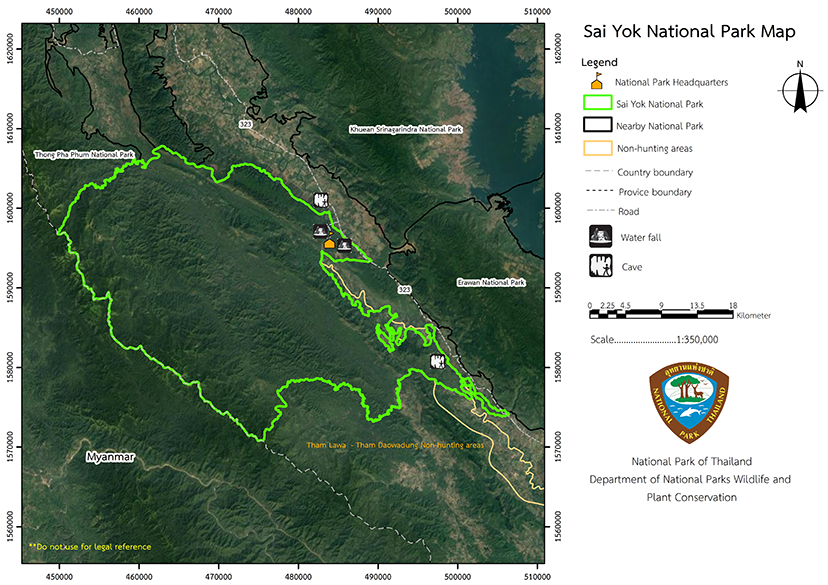
312,500 rai (500 square kilometers).
|
|
|
|
|
|
|
|
|
Nature trails ⇔ Visit Waterfall ⇔ Cave exploration/Geological condition ⇔ Observe flowers/plants ⇔ Bird/Butterfly ⇔ Take a boat ride or a paddle ⇔ History/Culture ⇔ Camping
Welfare shop : Open daily from 7:00 to 16:30 hrs. and sells coffee, drinking water, and snacks.
Mobile phone signal:
National Park Headquarters: AIS, TRUE, DTAC
|
|
The general topography of the national park consists of mostly folded complex mountains with an average elevation ranging from 300 to 600 meters above sea level. Gradients are steeper on the western side. The highest point in the national park is Khao Ro Rae, which is approximately 1,132 meters high and located on the southeastern boundary line. Next to the foothills is an undulating plain in between valleys and rivers, which was formed by sediments from the rivers, These areas are not very large due to the fact that most of the area are valleys. |
|
Sai Yok National Park is abundantedly forested highlands, and there is also a long ridge that separates Thailand from Myanmar. As a result, the climate in the area varies greatly. It is affected by monsoons, which makes the air cool and dry in winter and very wet during rainy season. Refer to the data from the Meteorological Monitoring Station in Mae Klong River, which is closest to Sai Yok National Park, the climatic characteristics can be summarized as follows: Seasons: There are three distinct seasons, Rainfall: |
|
|
|
Natural Vegetation From the readings and interpretations of the satellite images and a ground inspection in 1990, the forest area in Sai Yok National Park is divided into seven parts. The size of each component is expressed as a percentage of each site in Figure 10. The Royal Decree stated the park covers an area of 958 square kilometers, and it shows the different ecosystems. The satellite images helped discover, important plant species. The primary ecosystem in the Sai Yok National Park area is a mixed deciduous forest. The mixed deciduous forests cover an area of 810 square kilometers, accounting for 84.5% of the Sai Yok National Park. They can be divided into mixed deciduous forest and bamboo forest. The remaining 15.5% can be divided into dry evergreen forest and deciduous dipterocarp forest, although some areas have been encroached onto by locals and are used as agricultural land. Mixed Deciduous Forest Important plants in the forests include Dalbergia cultrata, Vitex peduncularis Wall.ex Schauer , Casearia grewiifolia Vent, Millettia leucantha Kurz, Zollingeria dongnaiensis Pierre, Rosewood, Javanese Cassia, Anogeissus acuminata (Roxb. ex DC.), Lagerstroemia duperreana Pierre ex Gagnep , Lagerstroemia duperreana Pierre, Cratoxylum formosum (Jacq.) Benth , Cratoxylum formosum, Bridelia retusa (L.) A.Juss, Indochinese Milla, Polyalthia viridis Craib, Paranephelium xestophylum Miq, Cananga latifolia (Hook.f. & Thomson) Finet & Gagnep, and Dillenia parviflora Griff. The lowest level at 10 - 15 meters high is home to important plants such as Millettia brandisiana Kurz, Blackwood, Lagerstroemia venusta Wall, Fernandoa adenophyla (Wall. ex G.Don) Steenis, Garuga pinnata Roxb, Cratoxylum formosum, Larus brunnicephalus, Alangium salviifolium (L.f.) Wangerin, Sterculia guttata Roxb, Star Gooseberry, Thyrsostachys siamensis Gamble, Melocalamus compactiflorus, Broken Bones Tree, Buchanania lanzan Spreng, Aporosa villosa (Wall. ex Lindl.) Baill, and Bauhinia glauca. Dry Evergreen Forest The dry evergreen forest floor consists of the seedlings of the larger trees, such as Mesawa, Barking Deer's Mango, Resin Tree, Dipterocarpus turbinatus C.F., and others, such as Bandicoot Berry, Asiatic Bitter Yam, Ground Orchid, Actinoscirpus grossus (L.f.), Dioscorea myriantha Kunth, Harrisonia perforata (Blanco) Merr, Fever Vine, Hyacinth Bean, Peacock Ginger, Benghal Dayflower, Siam Weed, Orchid Tree, and ginger varieties. According to a survey of plant species in dry evergreen forests using 3 plots measuring 10 x 10 meters, it was found that this type of forest has its canopy covering about 65% of total area. A total of 31 species of wood were discovered, with the average cross-sectional area of 8.4 square meters per hectare. It has an average density of 207 tons per hectare. Deciduous Dipterocarp Forest There are 3 levels, with the highest level at about 20-25 meters. The important plants in this class are Dipterocarpus tuberculatns Roxb, Dipterocarpus obtusifolius, Kenari, Flemingia sootepensis Craib and Bombax valetonii. The second level is at 10 to 15 meters in height, and is home to important plants such as Iron Wood, Indian Laurel, Haldu Wood, Quercus kerrii Craib, Lannea coromandelica (Houtt.) Mer, Great Elephant Apple, Monkey Jack, Croton oblongifolius Roxb, and Aporosa villosa (Wall. ex Lindl.) Baill. The forest floor consists mainly of the saplings of the larger trees and other species such as Buchanania lanzan Spreng, Ceylon Oak, Orchid Tree, Bauhinia saccocalyx, Milkey Tree, Palmyra Palm, Yellow Latan Palm, Star Gooseberry, Java Plum, Burma Padauk, Indochinese Milla, Terminalia pierrei, Lagerstroemia duperreana, Antidesma puncticulatum Miq, Dalbergia cultrata Graham ex Benth, and the Metocalamus compactiflorus. The survey in the deciduous dipterocarp forest used 5 plots of 10 x 10 m size. It was found that this type of forest has its canopy covering about 55% of total area, with a total of 33 species of trees, an average cross-sectional area of 11.16 square meters per hectare, and an average density of 434 tons per hectare. Wildlife Resources The survey showed there are at least 294 wildlife species, divided into 220 genera and 102 families, consisting of 58 mammals, 115 wild birds, 36 reptiles, 15 amphibians, and 70 freshwater fish. According to this latest study, 27 species accounted for 46 percent of all mammals when species were counted. Despite the relatively large number of species, the number and likelihood of sightings are low due to encroachment by humans for farming and former timber concessions. Special mammals once found in the area include Schomburgk’s deer and Cervus eldi ( C.eidi). According to Guehler (1933), citing the testimony and photographic evidence of Mr. Luang Wisit, Kanchanaburi mayor, stated in 1932, that someone shot a male Schomburgk’s deer from a herd of Cervus eldi on the banks of Khwae Noi River near the Sai Yok National Park Headquarters, which was the last sighting report. However, Stockly (1933) refused to accept the Schomburgk’s deer photographic evidence of as a the genuinue hunt at the time. The area is also home to the world's smallest mammal, Kitti Hog-Nosed Bat (Craseonycteris thonglongyai). Its total body length is just 23-33 mm, with a wingspan of 22-26 millimeters and no tail. It weighs just 2 grams. Mr.Kitti Thonglongya observed the bat when collecting samples from Khang Khao Cave and Phra Cave in 1973. After conducting a research, he sent some samples to the Natural History Department of the British Museum, where it was found to be a new species. Mr. Kitti died in 1974. Mr.John E.Hill studied structure of the shape and found that special characteristics could not be classified within an existing bat family, so he named the bat after Mr Kitti. The Kitti Hog-Nosed Bat (Craseonycteris thonglongyai) was the first new family of bats in 66 years (Hill 1974) from the last naming of different families by Mr. G.S. Miller in 1907 (Lekagul and Mcneely, 1997). From the observation in April and July 1991, the Kitti Hog-Nosed Bat in Wang Phra Cave, which is located on the outer boundary on the southeast side of Sai Yok National Park area went out for food at 19.10 hrs. They fly alone which is different from Black-Bearded Tomb Bat, which departs in group from their resting places in Lo River between 18.35 - 19.50 hrs. The feeding area includes deciduous forests and teak forests. Duangkhae (1990) reported that the Kitti Hog-Nosed Bat emerges for 18 minutes in the morning and 30 minutes in the evening and does not travel more than a kilometer from the cave, and will not come out at all in low temperatures or if there has been heavy rain. Other mammal species found in the area include wild elephants (Elephas maximus), tapirs (Tapirus indicus), guar (Bos gaurus), and banteng (Bos javanicus ), which are particularly found in Ro Rae Valley, Huai Bong Ti Valley, and into the border mountain ranges. The conditions in the Sai Yok National Park are that of a complex hill forest similar those in Thung Yai Naresuan Wildlife Sanctuary in Kanchanaburi Province. It is mostly deciduous and dry evergreen forests, which are suitable for Asian Elephants and Guar rather than Banteng which they prefer the lower section of Sai Yok National Park and on the west bank of the Khwae Noi River within the Erawan National Park area. The mammals found in the area are classified according to their protected status under the Wildlife Preservation Preservation Act B.E. 2503 (1960). At the moment, only one species of most protected wildlife catagory 1 resides in the park, which is the Serow (Capriconis sumatraensis). There are 11 protected wildlife in category 2 which account for 19% of mammals found. They include Burmese Hare (Lepus peguensis), Sun Bear (Helarctos malayanus), Asian Black Bear (Selenarctos thibetanus), Indo-Chinese Leopard (Panthera pardus), Bengal Tiger (Panthera tigris), Lesser mouse-deer (Tragulus javanicus), Indian Muntjac (Muntiacus muntjak), Fea's muntjac (Muntiacus feae), Sambar Deer (Cervus unicolor), Gaur (Bos gaurus) and Banteng (Bos javanicus). The birds that appear in Sai Yok National Park area can be classified into 104 species of protected wildlife in Category 1 (90% of all birds). Important wild birds found were Kalij Pheasant (Lophura leucomelanos), White Peacock Pheasant (Polyplectron bicalcartum), Thai Peacock (Pavo mutrcis) (found In 1990 in mixed deciduous forests along the banks of Lo River branch of Noi River), Wreathed Hornbill (Rhyticeros undulatus), and Oriental Pied Hornbill (Anthracoceros albirostris). Among the birds listed as protected wildlife in Category 2, there are only four (accounting for 4% of the total number of birds found), including Green-Legged Partridge (Arborophila chloropus), Red Junglefowl (Gallus gallus), Hick-Billed Green Pigeon (Treron curvirostra) and Mountain Imperial Pigeon (Ducula badia). Additionally, seven species of birds were found (accounting for 6% of all birds that are not protected by law). Reptiles A total of 17 important and legally protected wildlife are in Category 1, representing 19 percent of the total reptiles found, including Big Headed Tortoise (Platysternon megacephalus), which was described by Taylor in 1970. The tortoises are found near bodies of water, streams, and in hillside forests. Additionally, another 27 species (representing 75% of the reptiles) were found. A rare and interesting species includes Siamese Narrow-Headed Softshell Turtle (Chitra indica), which is one of the largest turtle species in Thailand. It can be found in Khwae Noi, Khwae Yai, and Mae Klong rivers. Occasionally, fishermen in this area see them, mainly during the spawning season on the sandy shores. Amphibians Amphibians found in the area are mainly from the Ramidae family, such as Puddle Frog (Occidozyga lima), Green Paddy Frog (Rana erythiaea), Asian Grass Frog (Rana limnocharis), Dark-Sided Chorus Frog (Rana nigrovittata), and Giant Asian River Frog (Rhinophis blythii), which is the only amphibian in the protected wildlife in Category 2. Protected wildlife Category 1 includes members of Toad family, including 3 types of Bufonidae, whichs account for 20% of all amphibians found, namely Asian Small Toad (Bufo parvus), Grey Cave Toad (Bufo macrotis) and Giant Jungle Toad (Bufo asper). Members of the Rhacophoridae Family also reside there, including Malayan Flying Frog (Rhacophorus leucomystex), Microhylidae Family Striped Sticky Frog (M.ornate), and Asian Painted Frog (Raloula pulchrs), which are found quite easily during rainy season. Freshwater Fish The Sai Yok National Park receives significant amounts of water from the Khwae Noi River and various other waterways , such as the Khwae Noi River Sai Yok Creek, Bong Ti Creek, and others. The Khwae Noi River is home to at least 70 fish species belonging to 48 genera and 20 families. The area's sample contained 17 species, accounting for 24% of the total known, with the others known from the Johnsen report (1963, 1964 a,b) and from the Smith paper (1945). Most of the fish are found to belong to the Cyprinidae family, which was 37 species , accounting for more than half of the fish species in the hKwae Noi River. These include Celtrops, Oxygaster, Paralaubuca, Rasbora, Danio, Soldier River Barb (Amblyrhyn chinchthy truncates), Hampala Barb (Hampala macrolepidota), Sultan Fish (Leptobarbus hoevenii), and other bards. Another family of fish found is Dusky-Hairfin Anchovy (Setipinna mela), Yellow Mystus (Mystus nemurus ), and Banded Leafish (Pristolepis fasciayu). |
How to get there by car :
- National Park Ranger Station Tho Yo No. 1 (Namtok Sai Yok Noi )
- National Park Ranger Station Tho Yo No. 2 (Tham Dao Wadueng)
- National Park Ranger Station Tho Yo No. 3 (Tham Lava)
- National Park Ranger Station Tho Yo No. 4 (Bong Ti Noi)
- National Park Ranger Station Tho Yo No. 5 (Mae Nam Noi)
- National Park Ranger Station Tho Yo No. 6 (Khao Phlu)
- National Park Ranger Station Tho Yo No. 7 (Namwon)
- National Park Ranger Station Tho Yo No. 8 (Khao Ruak)
- National Park Ranger Station Tho Yo No. 9 (Pong Khai)
Accommodation - Sai Yok 205 (Phanasan)
- Sai Yok 105 (Wiman Phrai)
- Sai Yok 201 (Klang Dong)
- Sai Yok 202 (Phong Phrai)
- Sai Yok 203 (Sai Yoi)
- Sai Yok 204 (Roi Pa)

